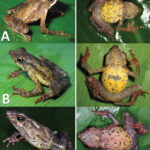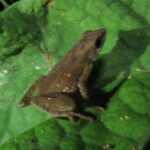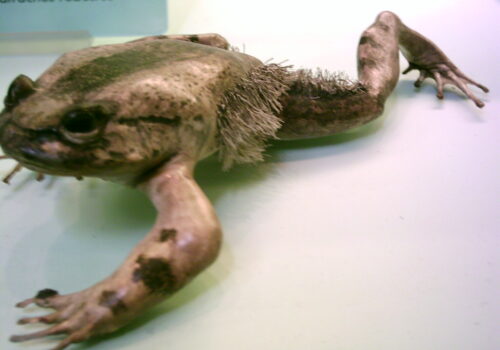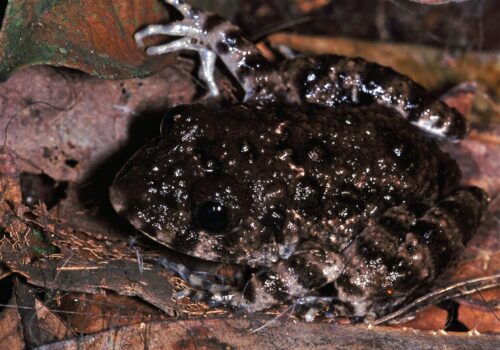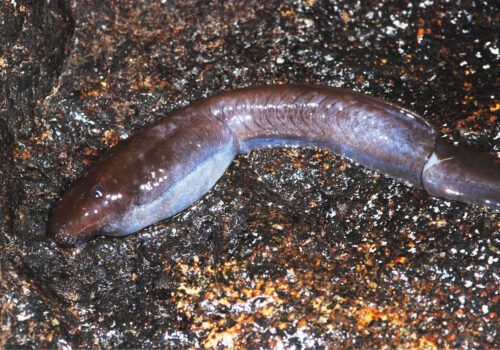- Unearthing the Secrets of Leptopelis modestus: The Humble Forest Tree Frog of Africa
- Taxonomy and Classification: Unraveling the Amphibian Lineage
- Natural Habitat: A Symphony of Life Beneath the Canopy
- Physical Characteristics: Understated Elegance in the Vegetation
- Behavior and Life Cycle: Quiet Life, Intricate Rituals
- Ecological Role: Subtle yet Crucial Connections
- Threats and Conservation Status: A Call for Awareness and Action
- Cultural and Scientific Significance: Beyond Nature's Delight
- Conclusion: Celebrating Modesty, Preserving Diversity
Unearthing the Secrets of Leptopelis modestus: The Humble Forest Tree Frog of Africa#
Hidden beneath vibrant emerald leaves, dappled in shadow and cloaked in the music of running streams and rustling foliage, a small frog goes silently about its business. While less celebrated than its exuberantly colored relatives, Leptopelis modestus—commonly known as the Modest Forest Tree Frog—is an elusive character, waiting patiently to be discovered by attentive eyes and sensitive ears. With a gentle call that floats softly through the evening mist, this unassuming amphibian thrives quietly in the tropical forests and wetlands of eastern Africa, intriguing researchers and nature lovers alike.
Comprising the delicate balance between exquisite adaptation and subtlety, the Modest Forest Tree Frog holds secrets that not only fascinate scientifically but also illuminate our understanding of Africa’s complex biodiversity hotspots. Let us embark on a journey into the world of Leptopelis modestus, exploring the intricate details of its life history, behavior, ecological significance, and urgent conservation needs.
Taxonomy and Classification: Unraveling the Amphibian Lineage#
Belonging to the family Arthroleptidae, the Modest Forest Tree Frog is officially designated as Leptopelis modestus. This family, deeply entwined with Africa’s biodiversity landscape, contains a variety of fascinating tree and shrub-dwelling species. First described scientifically in detail by Werner in 1898, this modest amphibian shares its genus Leptopelis with approximately 50 recognized species, each uniquely adapted to forested and streamside habitats across sub-Saharan Africa.
The genus name “Leptopelis” translates roughly as “slender pelvis,” a reference to subtle anatomical adaptations these frogs carry for agile arboreal movement. Within its genus, Leptopelis modestus sits relatively discreetly. Despite sharing ecosystems with better-known relatives like the Large-eyed Forest Tree Frog (Leptopelis vermiculatus), modestus is quieter in coloration and habits, earning its common name reflective of its humble character.
Natural Habitat: A Symphony of Life Beneath the Canopy#
Native primarily to regions within Tanzania, Kenya, Malawi, Mozambique, Zambia, and Zimbabwe, Leptopelis modestus inhabits diverse ecosystems characterized mainly by wet woodland, lowland tropical and subtropical forest margins, and moist savanna environments. These frogs exhibit a preference for areas close to permanent water sources, frequently found perched gracefully amongst the lower foliage, making them integral residents within the lush forest understory.
To immerse oneself in the habitat of these frogs is to step into a vibrant tapestry of life. Sunlight filters softly through a thick canopy of trees, casting intricate patterns onto leafy shrubs and vines that wreath the forest understory. Humidity infuses the air generously, enveloping all in a palpable layer of moisture, vital not only to Leptopelis modestus but to countless organisms sharing their ecosystem. The ambient sounds—the murmur of brooks, the call of forest birds, and the subtle chorus of amphibian calls at dusk—create an orchestral backdrop that neatly encapsulates the richness where this remarkable frog thrives.
One of the most distinctive habitats favored by Modest Forest Tree Frogs involves untouched streamside vegetation. The close proximity of permanent streams provides critical moisture, egg-deposition sites, and reliable hunting grounds, allowing the modest frogs to flourish in perfect harmony with the aquatic cycles that shape their terrestrial life.
Physical Characteristics: Understated Elegance in the Vegetation#
Subtlety defines the appearance of the Modest Forest Tree Frog. Typically measuring between 30 to 45 millimeters (1 to 1.7 inches) in length—females being slightly larger than males—this species takes elegance from simplicity. The gentle contours of its compact body and limbs carry surprisingly powerful musculature, enabling energetic leaps from twig to leaf amid dense bush and tree branches.
The coloration of Leptopelis modestus is typically a visual embrace of gentle olive-green, brown, or grayish hues, finely speckled or mottled to provide exceptional camouflage against leaves and bark. Their large eyes, a hallmark feature of arboreal frogs, feature horizontal slit-like pupils well-adapted to nocturnal activity and sudden changes in light intensity beneath the forest canopy. Although modest in appearance, these adaptive strategies in coloration and build allow the frog to evade detection by the ever-watchful eyes of predators, blending seamlessly into their leafy homes.
Behavior and Life Cycle: Quiet Life, Intricate Rituals#
The life of a Modest Forest Tree Frog unfolds quietly yet elegantly in the embrace of humid forests. Primarily nocturnal, Leptopelis modestus emerges from daytime resting spaces sheltered deep within plant foliage as dusk settles gently into night. Embodied in their nightly routines is a masterclass in predator avoidance, each cautious movement meticulously calculated to mask their presence from potential threats such as birds, snakes, and small mammals.
Feeding Habits and Preferences#
Like many tree frogs, the primary diet of Leptopelis modestus consists mainly of small invertebrates, insects, arachnids, and occasionally small mollusks. Ambushing prey from strategic points along branches and leaves, the frogs rely upon excellent vision and powerful leaps for successful hunting. Observers lucky enough to witness their feeding rituals speak of rapid predatory strikes, eyes tuned acutely to detect approaching insects in dim forest lighting.
Breeding and Life Cycle#
The rainy season marks a crucial time in the frogs’ annual cycle. Male frogs strike up soft yet resonant choruses from strategic perches alongside waterside vegetation, their calls gentle and trilling—each note a carefully orchestrated endeavor to attract receptive females. Once attracted, mating pairs descend to aquatic habitats, where females lay gelatinous clutches of eggs attached to submerged or partially submerged vegetation.
The tadpoles of Leptopelis modestus, small and initially fragile, will spend several weeks developing in these aquatic nurseries. Morphing quickly into miniature froglets over several months, youngsters gradually venture forth onto the land where they discover secure refuges amid the surrounding terrestrial vegetation—a cycle endlessly entwined with seasonal rains and the rich biodiversity upon which their survival is dependent.
Ecological Role: Subtle yet Crucial Connections#
The ecological importance of Modest Forest Tree Frogs cannot be overstated. These amphibians serve as both predator and prey, binding vital links within the delicate web of forest biodiversity. Their diet delivers natural control to insect populations, moderating cycles that benefit plant growth and reduce pest pressure on surrounding forest systems.
Simultaneously, their presence sustains a variety of forest predators. As prey items, these frogs are notably significant sustenance for a variety of birds, snakes, mammals, and even larger amphibians, reaffirming their pivotal place in the ecostructure of African forests. Like quiet custodians, their consistent presence reflects habitat health, positioning them as authoritative indicators of ecosystem integrity and water quality.
Threats and Conservation Status: A Call for Awareness and Action#
As with many amphibian species globally, habitat loss, pollution, climate change, and disease present significant challenges to the survival of Leptopelis modestus. Currently listed by the IUCN Red List as “Least Concern” due to broad distribution, their locally fragile populations require closer monitoring as anthropogenic pressures and deforestation intensify in East Africa.
Proactive conservation efforts, including sustainable forestry, watershed protection programs, and biodiversity inventories, represent crucial avenues to securing habitats crucial for this species. Additionally, communities committed to conservation education and environmental stewardship play essential roles in protecting these frogs from encroaching threats.
Cultural and Scientific Significance: Beyond Nature’s Delight#
Though perhaps quieter than their vibrant or dramatically venomous amphibian cousins, the Modest Forest Tree Frog holds discreet significance both culturally and scientifically within its native range. As symbols of environmental health and ecological prosperity, their calls and presence have inspired local folklore and stories passed across generations. Scientifically, these frogs carry valuable insights into climatic variability, pollution tolerance, and the intricacies of forest succession.
Conclusion: Celebrating Modesty, Preserving Diversity#
In supporting the preservation and appreciation of gentle species like Leptopelis modestus, we dive profoundly into the intertwined complexities that sustain life on our planet. Celebrating the modest, seemingly unsung heroes of the natural world provides a powerful motivation for conservation advocacy. Together, through awareness, education, and active stewardship, we can ensure that their gentle calls continue to enrich the twilight chorus of African forests for generations to come.


